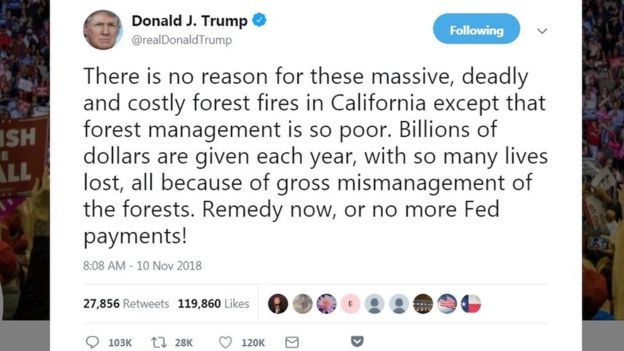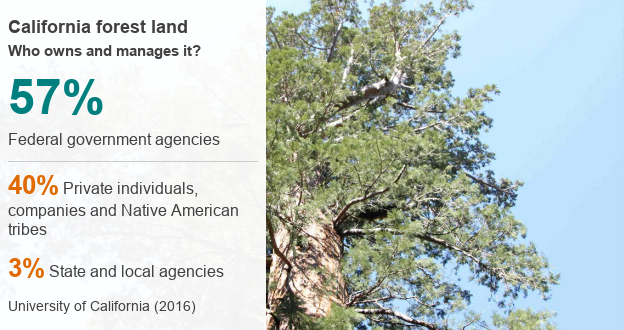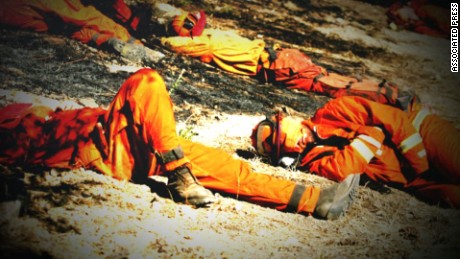
President Trump has blamed "poor forest management" in California for the wildfires that have swept across the state.
In a couple of tweets, he has suggested that the state has not managed its forests properly, despite receiving "billions of dollars" each year. The comments came shortly after he issued an emergency declaration to allow US federal government funds to be used to tackle three blazes in the state. 
There was an angry response from firefighters, including the president of the California Professional Firefighters, who said the assertion forest management policy was to blame was "dangerously wrong".
The International Federation of Firefighters - which represents members across the US and Canada - attacked President Trump for suggesting he might cut off funding. Some of those fighting the recent fires have also pointed out that fires have started in open scrub or grassland rather than in forests.
The comments have also been criticized by some experts who say they ignore the bigger picture of climate change and population shifts in the state. But is there any substance in the president's remarks about forest management?
Some people were trapped in their vehicles by the flames as they were trying to evacuate.
Who manages California's forest?
Nearly 60% of California's forested areas are managed by national agencies such as the US Forest Service, the Bureau of Land Management and the National Parks service.And there's a significant amount in private hands as well.
The actual amount managed by the California state authorities is small - but the California Department of Fire and Forestry Protection is responsible for putting out fires and prevention measures in privately owned areas.

The national agencies have funds set aside for managing the land they own:
- The US Forest Service has a budget of $4.73bn for 2018, of which $2.4bn is for "fire suppression and preparedness"
- The Bureau of Land Management had a budget of $1.3bn in 2017, although it's not clear how much was for forest management or fire prevention
- The National Parks Service's anticipated budget for 2019 is $2.2bn, with $289.2m for "resource stewardship"
Scott Stephens, a leading authority on wildfires at the University of California, has for some years been questioning forest management priorities. He believes more focus needs to be put on more on sensible management of the environment and better land use to avoid "catastrophic burning".
He has also pointed to the large number of dead trees in parts of the state, due to drought and disease, as a serious fire risk that needs to be addressed.
Tom Bonnicksen, professor of forest science at Texas A&M University, says the real issue is that there are too many trees in California's forests, which he said was the "underlying cause of the wildfire crisis". He believes forests need to be thinned out.
About ninety percent of the homes in the town of Paradise California were totally destroyed.
The death toll from the fires has risen to 56 and 100 people are still missing.

A man delays his evacuation to watch everything he owns burn to ashes
How could forests be managed differently?
Prof Stefan Doerr, at Swansea University, says the modern policy of putting out all fires in wild areas may have been misguided. For centuries, Native American peoples would burn parts of the forest so they could hunt or gather plants that grow in the cleared areas and that would thin out the more flammable vegetation and make forests less dense."But in the recent century or so, the emphasis has been on putting out any fires - and with climate change this has now created a tinderbox of vegetation," Prof Doerr said.
The case for allowing controlled fires to clear out vegetation also applies to other types of landscape such grass and shrub land, according to another expert. Even though they have no trees, these areas would also benefit from burning out potentially flammable material, the argument goes.
Is the problem getting worse?
There's little doubt fires have been getting worse in California in recent years, both in terms of their destructive power and their size. The ten biggest fires in American history have happened here.And in terms of loss of life and damage to property, the data shows the worst fires have all been in the past 10 years or so - except for one fire in 1991 in Alameda County.
Many experts point out that climate change has made things worse, leading to higher temperatures, lower humidity and changes in wind and rainfall patterns. Drought conditions for three years in California have led to vegetation drying out and becoming more flammable. Add to that the fact that winter seasons when it rains or snows are getting shorter.
California is also one of a number of US states where more and more people are moving out of the main urban centres and into rural or semi-rural areas.
A report by the US Department of Agriculture in 2010 noted that by that year more than 11 million people out of a population of some 37 million in California were living in such areas - and flagged the fire risks this posed.
Also, houses are often built of combustible materials such as wood. California state law does require homeowners to take steps to protect their properties from fire hazards, including clearing or reducing vegetation near properties. However, research by the Hoover Institute earlier this year raised concerns over public awareness, enforcement and the availability of up-to-date information about the areas at most risk.
There's little doubt that unless some of these issues are addressed, the costs to California - as well as to Washington - will grow. California's own fire service is estimated to have spent more than $770m in the past fiscal year on putting out fires. Its budget was just under $443m.
And as of September 2017, the US Forest Service said it had spent more than $632m on fighting fires in California and that nationally the costs of fighting fires were increasing by $100m each year.
Some volunteer fire fighters are convicts who are rewarded with reduced sentences

Exhaustion overtakes firefighters
A Savage and merciless blaze brought on by climate change for the most part, not by the incompetence of forestry agencies. However, since the citizens never seem to be prepared for this almost annual event, it would be prudent for state government to educate people on how to protect themselves and how to evacuate quickly and orderly. And perhaps the gov't should organize a huge force of standby volunteer firefighters and devise a few new methods for getting a blaze under control more quickly. Under the circumstances, it's a pretty good way to spend taxpayer dollars.



No comments:
Post a Comment
Through this ever open gate
None come too early
None too late
Thanks for dropping in ... the PICs